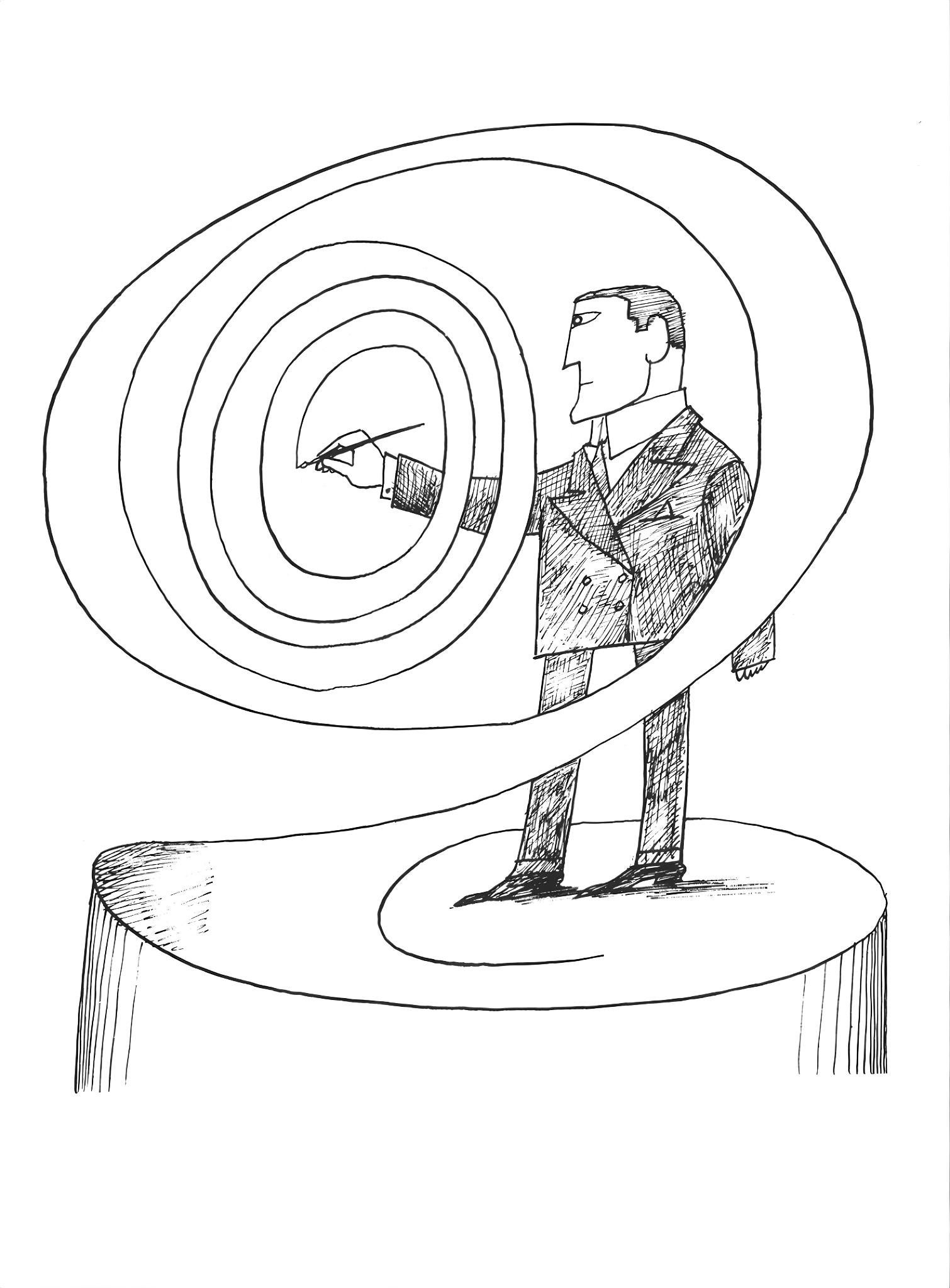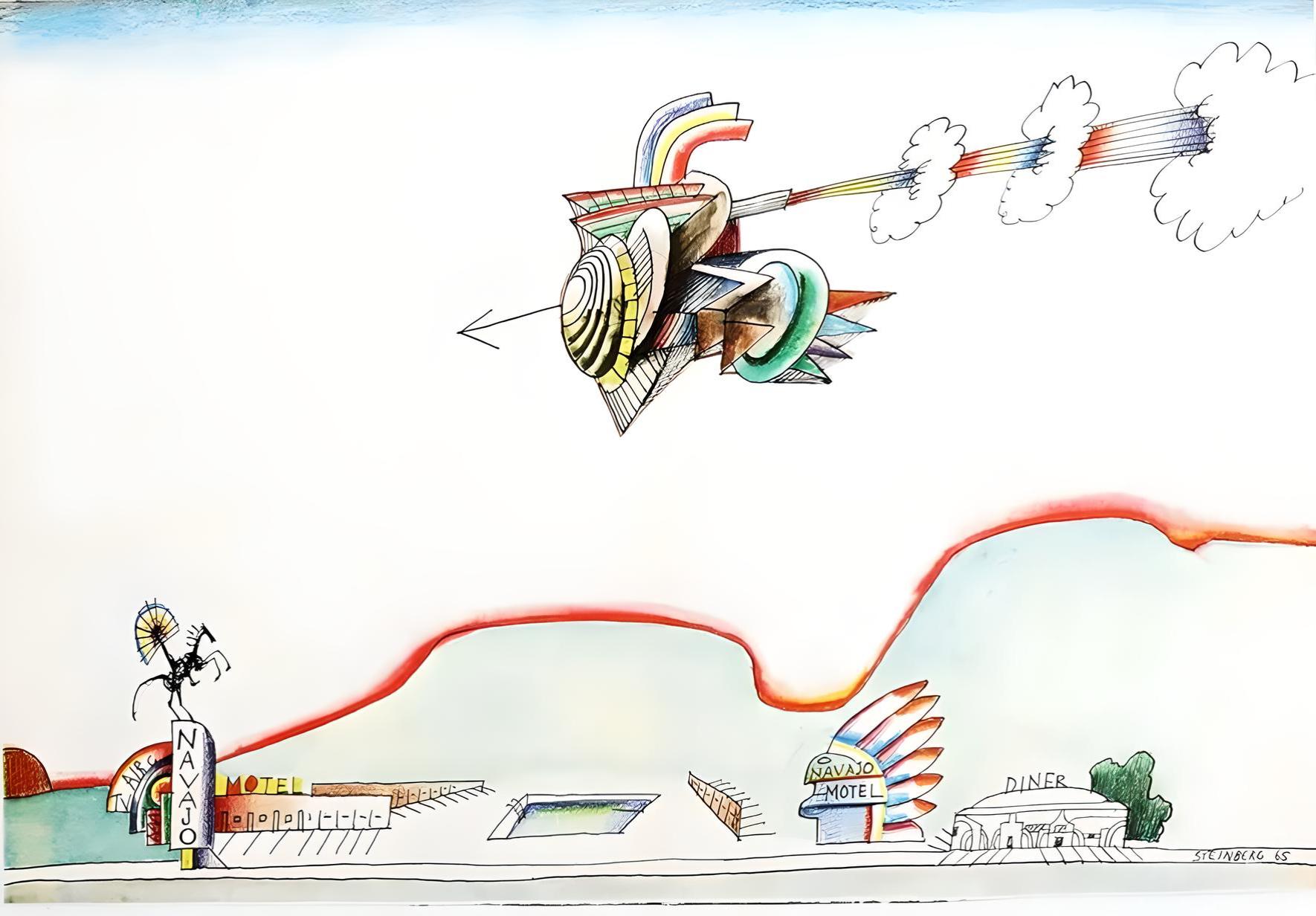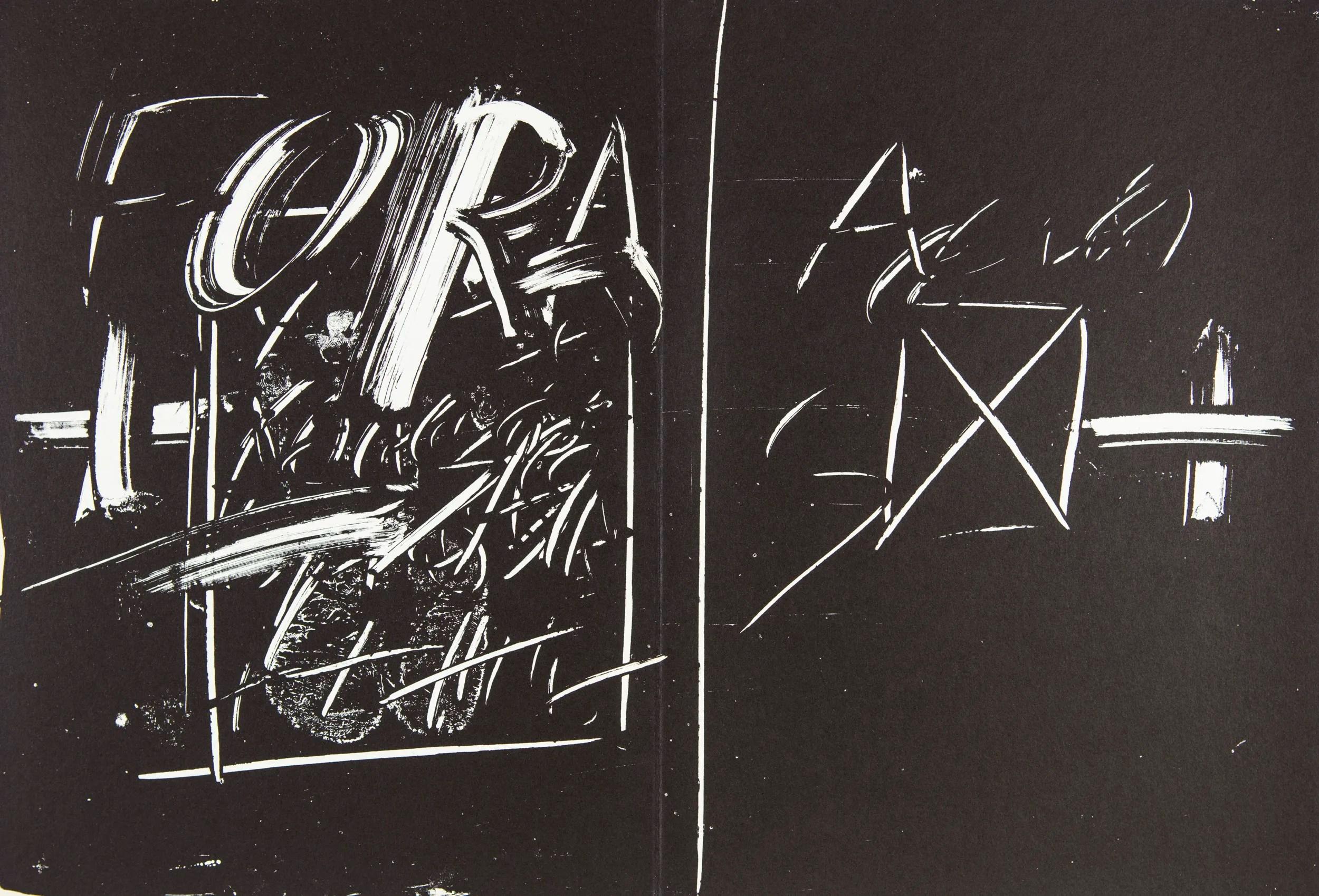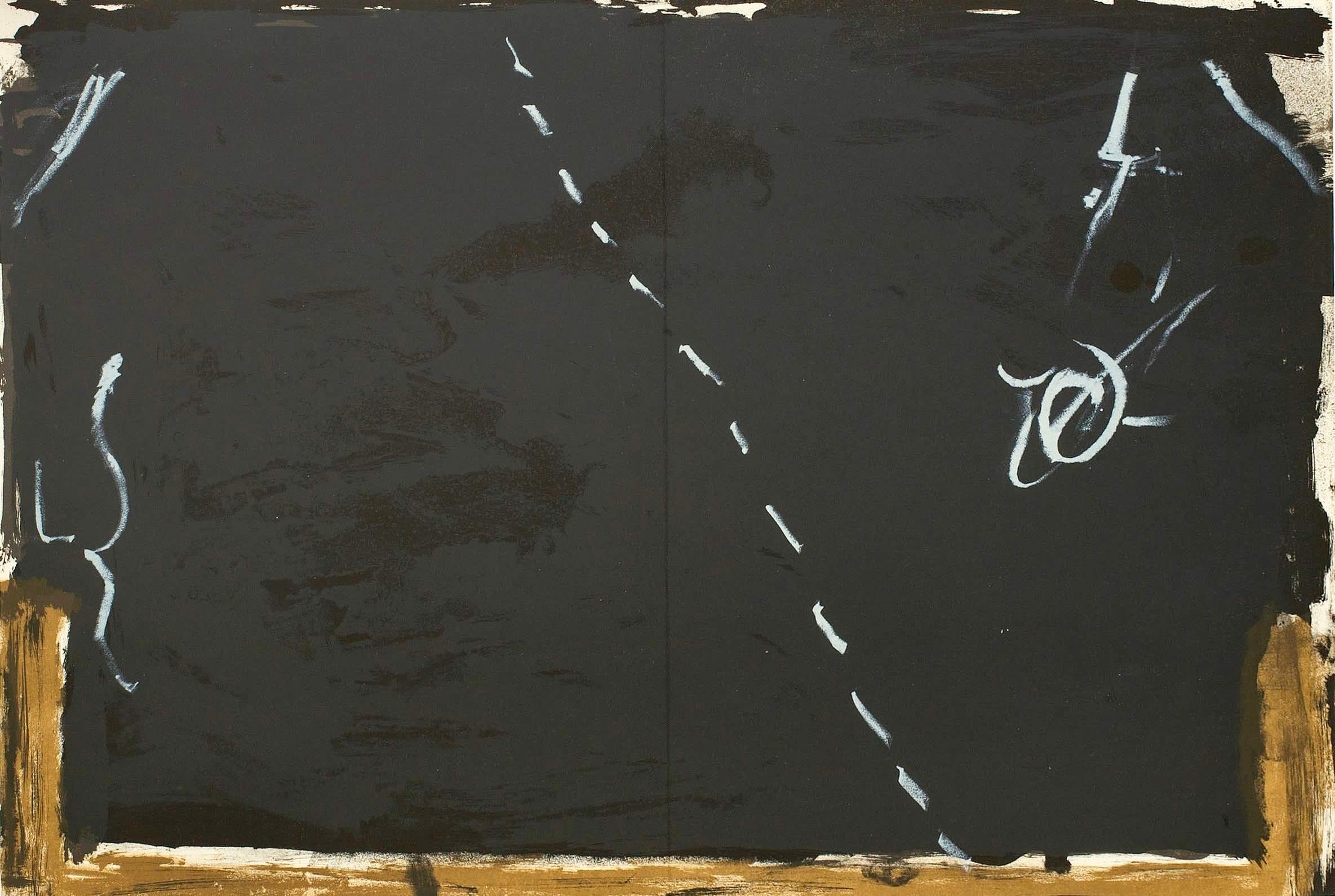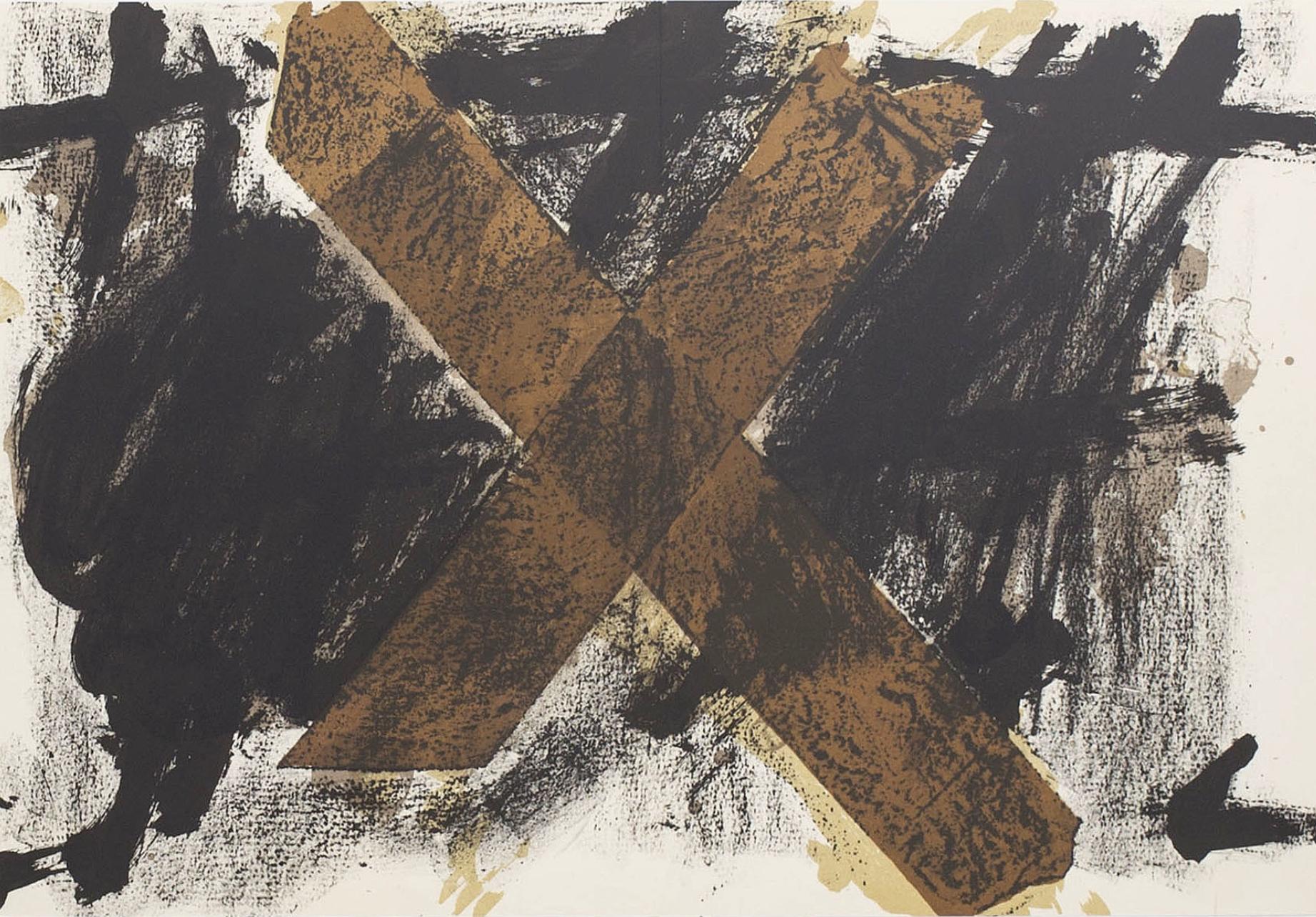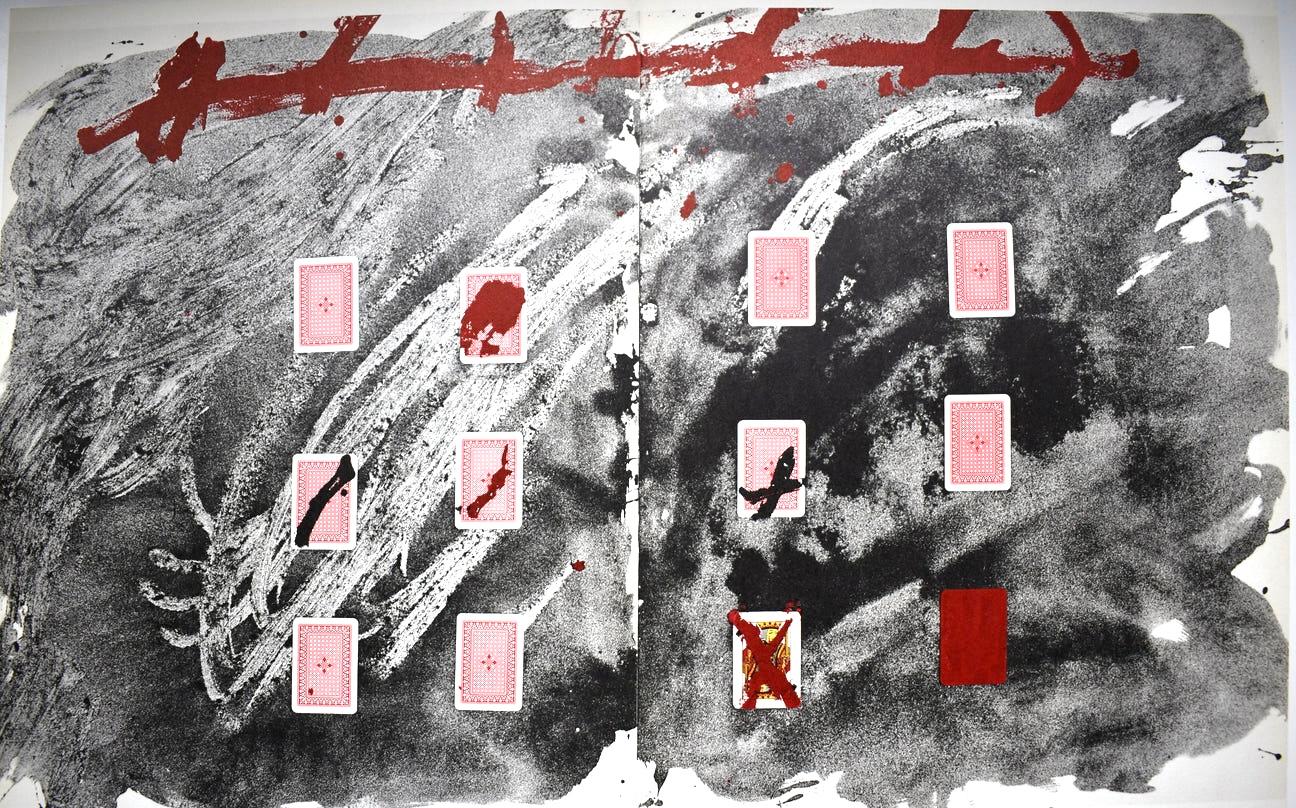Items Similar to Tàpies, Composition, Derrière le miroir (after)
Want more images or videos?
Request additional images or videos from the seller
Tàpies, Composition, Derrière le miroir (after)1982
1982
About the Item
Lithograph on wove paper. Inscription: Unsigned and unnumbered. Good Condition; with trifold, as issued. Notes: From Derrière le miroir, N° 253, published by Derrière le miroir, Paris; printed by Galerie Maeght, Paris, 1982. Excerpted from a Christie’s, New York lot essay, The life span of Derrière le Miroir was thirty-five years. Publication began in 1946. Aimé Maeght, initiator of Derrière le Miroir, had already made few attempts to start publications illustrated with fine printed lithographs in colours in the years prior to the launch of Derrière le Miroir. The name, Derrière le Miroir was suggested by Jacques Kober, manager of Galerie Maeght. The gallery had opened in 1945; the first number of Derrière le Miroir was released a year later. For this first issue Geer van Velde was invited to create lithographs to illustrate the publication. The lithographs in the first issue was printed by Mourlot, Paris. The first three issues of Derrière le Miroir were unsuccessful for Maeght as far as the edition size—the initial print-runs were far too large. From 30,000 for the first issue, the number was taken down to 10,000 for numbers two and three, until Derrière le Miroir number four was published in an edition of 1500. Maeght instituted a policy whereby unsold issues were recycled and used for the fabrication of new paper for the coming editions—this served to both conserve resources and also usually result in ultimate edition sizes far less than 1,500. With number four, the permanent format for Derrière le Miroir was established. Lithographs in colours were key; text was limited to comments on the featuring artist's exhibition taking place in the Galerie Maeght, and this catalogue format was defining to Derrière le Miroir. Galerie Maeght took on the leading role in Paris and presented all main artists including Braque, Matisse, Chagall, Léger, Bonnard, Chillida and many more. So too did Derrière le Miroir. The idea of a magazine was meanwhile still on the mind of Aimé Maeght. He found an insert as a solution. Two, and later four, pages of art review were inserted from 1952 onwards. In 1968 this find had ripened to independency and the dream of Aimé Maeght was now a tangible fact named l'Art vivant. Derrière le Miroir was on it's own again. Over 250 issues in a row. At that point publisher Aimé Maeght wished to make a mark with the publication of an hommage to all who once contributed to the magazine which came in the form of issue number 250, but was delayed by the death of Aimé Maeght. It was published after number 253 in 1982 and became a tribute to Aimé and Marguérite Maeght and 35 years of friendship with artists and poets. The era of Derrière le Miroir was closed with that final publication.
ANTONI TAPIES (1923-2012) was a Spainish painter, sculptor and art theorist. Tàpies was first introduced to Modern Art as he entered secondary school in 1934. He saw a famous Christmas issue of the magazine, D’ací i d’allà, which contained reproductions of works by artists such as Marcel Duchamp, Georges Braque, Wassily Kandinsky and Pablo Picasso. At 17, Tàpies suffered a near-fatal heart attack caused by tuberculosis. He spent two years as a convalescent in the mountains, reading widely and pursuing an interest in art that had already expressed itself when he was in his early teens.
- Creation Year:1982
- Dimensions:Height: 15 in (38.1 cm)Width: 33 in (83.82 cm)
- Medium:
- Movement & Style:
- After:Antoni Tàpies (1923 - 2012, Spanish)
- Period:
- Condition:
- Gallery Location:Auburn Hills, MI
- Reference Number:1stDibs: LU1465214019962
About the Seller
4.9
Gold Seller
These expertly vetted sellers are highly rated and consistently exceed customer expectations.
Established in 2002
1stDibs seller since 2021
865 sales on 1stDibs
Typical response time: <1 hour
- ShippingRetrieving quote...Ships From: Clinton Township, MI
- Return PolicyA return for this item may be initiated within 1 day of delivery.
More From This SellerView All
- Tàpies, Composition (Galfetti 83-86), Derrière le miroir (after)By Antoni TàpiesLocated in Auburn Hills, MILithograph on wove paper. Inscription: Unsigned and unnumbered. Good condition. Notes: From Derrière le miroir, N° 168, published by Derrière le miroir, Paris; printed by Galerie Mae...Category
1960s Post-War Still-life Prints
MaterialsLithograph
- Tàpies, Composition, Derrière le miroir (after)By Antoni TàpiesLocated in Auburn Hills, MILithograph on wove paper. Inscription: Unsigned and unnumbered. Good Condition; with centerfold, as issued. Notes: From Derrière le miroir, N° 207, published by Derrière le miroir, P...Category
1970s Post-War Still-life Prints
MaterialsLithograph
- Tàpies, Composition (Galfetti 315), Derrière le miroir (after)By Antoni TàpiesLocated in Auburn Hills, MILithograph on wove paper. Inscription: Unsigned and unnumbered. Good Condition; with centerfold, as issued. Notes: From Derrière le miroir, N° 200, published by Derrière le miroir, P...Category
1970s Post-War Still-life Prints
MaterialsLithograph
- Tàpies, Composition (Galfetti 83-86), Derrière le miroir (after)By Antoni TàpiesLocated in Auburn Hills, MILithograph on wove paper. Inscription: Unsigned and unnumbered. Good Condition; with centerfold, as issued. Notes: From Derrière le miroir, N° 168, published by Derrière le miroir, P...Category
1960s Post-War Still-life Prints
MaterialsLithograph
- Tàpies, Composition, Derrière le miroir (after)By Antoni TàpiesLocated in Auburn Hills, MILithograph on wove paper. Inscription: Unsigned and unnumbered. Excellent Condition; with centerfold, as issued. Notes: From Derrière le miroir, N° 210, published by Derrière le miro...Category
1970s Post-War Still-life Prints
MaterialsLithograph
- Steinberg, Illustration, Derrière le miroir (after)By Saul SteinbergLocated in Auburn Hills, MILithograph on wove paper. Inscription: Signed in the plate and unnumbered; text on verso, as issued. Good Condition; with centerfold, as issued. Notes: From Derrière le miroir, N° 15...Category
1960s Post-War Abstract Prints
MaterialsLithograph
You May Also Like
- Still Life - Original Lithograph by Emmanuel Poirier - 1950sLocated in Roma, ITStill Life is an original lithograph on ivory paper realized in 1950s by Emanuel Poirier. Signed on the lower left. Edition " E.A." (artist proof). T...Category
1950s Modern Still-life Prints
MaterialsLithograph
- Paris School Minaux Matisse Post-Impressionist Still Life Lithograph FlowersBy Andre MinauxLocated in Norfolk, GBSchool of Paris Artist, Andre Minaux (Paris 1923-86) Limited Edition 20/20, printed in 7 colours on Japon paper. Sheet size 57" x 38", image size 49" x 32" Signed Bottom right in pencil, editioned in pencil bottom left With a full sheet authenticity certificate, dated 1964 This is a fabulous original Limited Edition Lithograph, completely of its time when artists in Paris were pushing boundaries and trying to bring about new styles. The influence of artists like Matisse can be seen and Minaux was working alongside artists such as Picasso and with Bernard Buffet to reject ideas of Abstract painting. The text that accompanies the lithograph can be seen in the image of the certificate and is in French. The translation that follows on the certificate of Provenance gives an in depth description of this compelling still life: 'It is a singularly balanced art that that of André MINAUX, a typically French painting, made of power of clarity and nobility, in the tradition of our great modern masters as well as those of past centuries. And yet this painting under the hieratic appearance of the attitudes is not a wise painting, but on the contrary terribly dynamic, in which the passion and the virulence of the feelings are contained only by the simplicity and the purity of the forms. Each work of André Minaux is a miracle of balance between bubbling joy; joy of painting, joy of living; which animates the artist, and the voluntary serenity of the colors and volumes by which he translates his vision of beauty and grandeur. André Minaux's painting, full of a life in perpetual becoming, is the great and worthy expression of an art continually in evolution which moves without aggressiveness, but not without struggles, towards its final ends. And this painting, painting of an artist in full possession of all his means, of an extremely solid technique, and of a perfect trade is however that of a young person. Forty-one years is youth for a painter and at this age André Minaux, already recognized as one of the masters of the young French figurative school, has a future as brilliant and promising as behind him a long history of hard work and success. André Minaux is Parisian, born September 5, 1923. Very young he feels attracted to the graphic arts, he prepares and enters the School of Decorative Arts, but pure painting attracts him irresistibly and it is to her that he soon devotes himself exclusively. His young and great talent makes him quickly noticed. He first exhibited at the Salon des Sous de Trente Ans and later at other salons: des Indépendants, d'Automne, then at the Salon de Mai and at the Tuileries. In 1948 first private exhibition in Paris, others will follow in 1951, 1956 and 1957. In the meantime two exhibitions equal ment were devoted to him in London in 1953 and 1957. His last was a very important exhibition in 1963 at the David and Garnier Gallery in Paris. In 1949 at the 'Ecole de Paris', Galerie Charpentier, he had already won the Critics' Prize. Its reputation extends abroad thanks to numerous demonstrations of groups in England, Germany, Australia, Canada, Japon, U.S. A., etc... The Museum of Modern Art in Paris, several museums in the provinces, the Tate Gallery in London, have works by André Minaux, and his paintings can be found in major collections in Paris, London, New York, Tokyo, Stockholm, etc. ... Member of the French engraver painters, André Minaux is a remarkable lithographer, his lithographed work is already very important, he is also a member of the "Comité National du Livre Illustré Français and he has illustrated a certain number of luxury books...Category
1960s Post-Impressionist Abstract Prints
MaterialsLithograph
- Vintage Original Poster Sister Corita Kent Lithograph Pop Art "Life Without War"By Mary Corita (Sister Corita) KentLocated in Surfside, FLCorita Kent (American, 1918 - 1986)"We Can Create Life without War" Corita Billboard Peace Project Poster 1985 Corita Billboard Event - Part of Peace Week, January 17-24, 1985 San Lu...Category
1980s Pop Art Abstract Prints
MaterialsLithograph, Screen, Offset
- Le masque à gaz, Gas Mask Hand Signed Lithograph SilkscreenBy ArmanLocated in Surfside, FLLe masque à gaz, 1971, edition of 300. Signed "Arman" in pencil l.r., numbered in pencil l.l. Lithograph in purple and gold on paper, image size 25 3/8 x 19 3/8 in. (64.3 x 49.0 cm),...Category
1970s Abstract Abstract Prints
MaterialsLithograph
- Violent Violin Concerto Hand Signed Lithograph SilkscreenBy ArmanLocated in Surfside, FLArman (November 17, 1928 – October 22, 2005) was a French-born American artist. Born Armand Fernandez in Nice, France, Arman was a painter who moved from using objects for the ink or...Category
1970s Abstract Abstract Prints
MaterialsLithograph
- 1940's Abstract Composition Jazz Lithograph Pencil Signed and Dated WPA ArtistBy Konrad CramerLocated in Surfside, FLKonrad Cramer, 1888-1963 was a painter, photographer, printer, and illustrator. Based in the fertile Woodstock, New York, artistic community along with Yasuo Kuniyoshi and Russell Lee, Cramer was both educator and artist. He ran a summer school for miniature camera photography in the 1930s and later taught one of the first American college courses in photography at Bard College. Although he began as a painter of abstract, geometric forms in bold colors, Cramer is most known as a photographer. Konrad Cramer was born and raised in Wurzburg, Germany. Cramer studied to be an artist at the Karlsruhe Academy under Ludwig Schmidt-Reutte and Ernest Schurth. He became interested in the German avant-garde early in his schooling, he was a member of the Blaue Reiter, exposed and encouraged by the experimental works of Wassily Kandinsky and Franz Marc. An additional influence on Cramer's artistic development was the Cubist landscapes of Paul Cézanne. Florence Ballin Cramer opened a gallery on 57th Street in 1919, encouraged by the sculptor Elie Nadelman. Florence Gallery exhibited and sold the works of living artists. Although it only survived briefly, it was the first New York gallery to show works by Yasuo Kuniyoshi, Alexander Brook, Ernest Fiene, and Stefan Hirsch. Cramer then settled with his wife in Woodstock, New York, where Ballin had painted with the Art Students League each summer since 1906. Cramer established a reputation as one of Woodstock's most modern painters with an impressive series of abstract paintings exhibited at the MacDowell Club in 1913. In the 1920s Cramer developed a personal representational style which blended modern and regional influences. Cramer received a Rockefeller grant in 1920 to study educational methods for craftsmen in Germany and France. In 1922 he took a teaching position at the Woodstock School of Painting and helped establish the Woodstock Artists Association, where he served as a director. While teaching and painting, Cramer also applied his artistic talent to illustration and textile design. Konrad Cramer first exhibited at the Whitney Studio Club in 1924 and participated in the Whitney Museum of American Art's first and second biennials in 1933 and 1935. He was also included in the 1935 exhibition Abstract Painting in America at the Whitney. Cramer was later included in the Whitney Museum exhibition Pioneers of Modern Art in America in 1946. In the 1930s Cramer participated in many other museum invitationals, including: the Carnegie International (1929, 1933, 1937, 1938); the Pennsylvania Academy of the Fine Arts (1934, 1936), and the Corcoran Gallery of Art (1935, 1937). In 1934 Konrad Cramer and his wife travelled to Mexico where they produced many paintings and drawings. Back in Woodstock in 1935, Cramer briefly joined the (WPA) Federal Art Project, administering the regional program in Woodstock. In the mid-1930s Cramer took up photography to clarify aesthetic issues in his painting. Cramer had gotten to know Alfred Stieglitz upon his arrival in America in 1911 and wrote an essay about 291 Gallery for Stieglitz's magazine Camera Work in 1914. Through Stieglitz and then in the 1930s fellow Woodstockers like Russell Lee, Cramer became interested in the possibilities of photography and began working with it as an artistic medium. In the 1950s Cramer collaborated on a traveling exhibition and book of abstract photographs with Manuel Komroff...Category
1940s Abstract Abstract Prints
MaterialsLithograph
